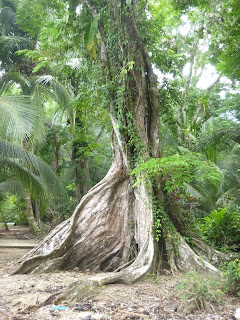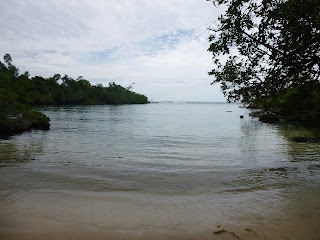Hola mis amigos!
When you live on a tropical island during the rainy season, it rains. It rains a lot. For weeks straight. So when it gets sunny, it's time to go outside and go DO stuff. (It is of course, totally possible to do stuff in the rain here, because the rain is so warm, but there are pros to not consistently damp.) This last week it's been beautifully sunny almost every day, so I have several adventures to report.
I'm going to give you a map here, so you can get an idea of where I was going on all of these adventures. So, thanks to Google Maps and Paint, I give you: The Panama Adventure Map!
The three islands to the south east of Isla Colon are Carenero, Solarte, which are both labelled on the map, and Bastimentos, which is the upper one with Wizards and Dreffle Beach. I haven't been to Solarte yet, but I have been to Carenero and Bastimentos! Things that are circled in red are locations of adventures I've had since I last wrote.
Well, mostly. I did tell you a bit about my afternoon on Carenero, so I'll start there. Picture time!
Can you see the little bridge behind the palm tree? This is the path we were following along the edge of the island.
This is Bibi's, which is supposed to be a very good spot both for brunch. This is definitely still on my to-do list!
Ok, I love trees like this. I've seen them in many of the tropical places I've been; the Daintree Rainforest in Australia and Hawaii. I don't know, however, if they're all the same tree or if there is some kind of convergent evolution happening here.
This is looking north east from Carenero. The land you can see here is the tip of Bastimentos. The real purpose of this picture, though, is to point out where I went surfing with Sarah! You can see the water taxi here, and beyond the boat there were several surfers out there.
So...I guess taking pictures straight isn't my strong suit. But you can see the point that Amber and I climbed from here. That's about as far around the island as we walked; we decided we wanted to lay on the beach more than we wanted to keep exploring.
This picture, and the next one, were taken from me standing at exactly the same spot which I think is crazy! The first one, above, was taken looking to my left, and it's a marshy swampy kind of ecosystem.
This one, on the other hand, is pure beach. It was interesting to me that they existed so close together, and with such a sharp boundary.
And here we are at the point! This is looking back at where the waves hit it. Maybe someday it will be a blowhole, but right now the waves are just eroding this cave way back into it.
This is taken from the same spot, but it's looking on down the island, to where we didn't walk. I guess that's an adventure for another day!
Last Thursday, another new assistant arrived from Stonybrook. His name is Alex, and he's a master's student studying the genetic heritability of resistance to ocean acidification in fish. On Friday Amber and I introduced him to the system and a typical work day for us, and then on Saturday we decided it was time to do something fun. We decided to rent bikes and ride to La Piscina, a natural pool created by an indent in the land and a barrier reef. It's also circled on the adventure map; it's the north-most circle on the large part of Isla Colon. It's nine or ten miles from Bocas Town.
This is looking inland partway along the road on the way there. Most of this land is taken up by fincas, which are sort of like little farms or ranches. Whatever they are, it was outlandishly gorgeous.
And this is La Piscina, looking out to the north east. There's a barrier reef just about where the horizon of this picture is which keeps the water in La Piscina calm and creates a lovely habitat for all kinds of fish. It also means you can't get here by boat, and that paired with the long (and very muddy) road we followed out there means it's rare to see another person. We had the place to ourselves all day long.
This picture is taken from the same spot, looking to my left. I loved how this tree hung down over the ocean.
Here are Melissa and Alex, where we set up our little camp for the day. Alex wasted no time stretching out in the sun, while Amber and Melissa and I went for a swim out to the edge of La Piscina.
Ok, I couldn't help myself. This was at the top of one of the little hills on the way back, and I immediately stopped to take a picture. I am the luckiest girl in the world to get to work in a place like this!
Hannah Limov, this picture is especially for you. Many times in all this wonderful sunny greenness, I found myself reminded of your house in Northern California and of the trail we hiked at Point Reyes.
After the ride, we had to stop at the Smithsonian to rinse all the mud off our bikes. This is Amber, posing with our trusty steeds. We were definitely all tired and sweaty and really quite pleased with ourselves at this point.
On Sunday and Monday we were good children and went to work (and did laundry and various other important housekeeping things), but Tuesday was July 2nd, and therefore my birthday! To celebrate the occasion, we all got up early, finished the system check-up as fast as we could, and then bolted to Red Frog Beach, which is Bastimentos.
If you're ever in Bocas and you want a gloriously perfect classic beach, go to Red Frog. There is a resort on one end, but it's pretty hidden and it's nice to be able to get cold drinks. At the other end of the beach is a tent lodge; it's a super cool spot to hang out. Alex met a ton of young backpackers to hang out (and flirt) with there.
So you see what I mean by perfect classic beach? The sand was soft, the water was clear and a lovely temperature. I proceeded to spend the next three hours alternating laying in the sun and playing in the waves. As much as I love swimming of the dock and La Piscina was beautiful, I love playing in waves. Perhaps it's the distinct lack thereof in Colorado.
Here are Amber and Alex, enjoying the sunshine as well. Somehow I managed to take most of my photos during the twenty minutes it was cloudy...but it was lovely and sunny most of the day.
This is looking the other direction (more south) and towards the Red Frog Resort. Really, it's too pretty for words.
These next four pictures are for my dad. In this picture, Dad, are the boats we get to ride in. These are typical of the water taxis you use to get mostly anywhere. They're great for motoring around the different islands, and all the drivers I've met thus far have been friendly and helpful and only slightly solicitous.
This is the Red Frog Marina, just beyond the water taxis. These are all the boats we DON'T get to ride in, sadly enough. We saw a sailboat from Oslo among this bunch!
There were a couple of catamarans there also. Amber's comment as we rode by in the water taxi: "I wish I had a big enough boat that I needed a little boat to get to it."
On Wednesday we were good again and went to work. Amber left early on Friday morning to go to a cousin's wedding in Hawaii, so she was busy Wednesday and Thursday making sure everything was ready to go and that Alex and I knew how to take care of everything while she was gone.
Thursday morning I woke up and decided that I had way to much energy, so I promptly decided that my goal for the day was to wear myself out. To this end, I went for a run to Playa Ponch at about midday. If you scroll way back up to the adventure map, I circled Playa Ponch as well. It's along the same road that we used to get to La Piscina, but much closer! I ran to where the pavement ends, which is about a mile and a half past the Smithsonian. Amber and I had run/walked out there the week before, so I figured I could make it at least half-way without stopping. Remember, this is the girl who hasn't run for running's sake for at least two years.
But before I get anywhere, I see a group of people crowded around the Smithsonian gate. There was a sloth making his way along the fence! I promptly ran back up to get Amber and Alex, and we spent a good five minutes taking pictures of it. Then Amber and Alex returned to the lab and I proceeded with my run.
So I get about half-way, and I'm feeling good. Ok, I tell myself, let's run the whole way out there! So I did. Playa Ponch was beautiful; it was a gloomy could day and everything there was silvery and misty and lovely. I absolutely refuse to carry things when I run though, so there aren't currently any pictures of Playa Ponch. One day I'll ride the bike out there and get some pictures of it.
I hung out on Playa Ponch for a little bit, idly stretching and admiring the view. I was feeling pumped at that point, so I decided I was going to run all the way back. I managed it on the way out, right?
Two-thirds the way back, I wasn't sure about that idea anymore. Another couple of minutes down the road, my shoe came untied, and I wasn't entirely displeased with the fact that I had to stop and tie it up again!
The sun came out about an hour after I got back, and Amber, inspired by my energy, decided to swim out to the sea grass bed off our dock and look around. I went too, and we saw a lobster, a lot of starfish and sea urchins, and Amber was very excited about the mix of sea grass. Her lab at home does mostly sea grass research.
After about an hour's swim, we headed back to the dock and cleaned up, before deciding that yoga sounded like a great idea. The woman who runs the classes is completely crazy and completely wonderful. Amber and I've been going about twice a week, and it's a lot of fun.
It wasn't until I got home that I realized exactly how well I'd done with my goal of wearing myself out. I'd run three miles, swum for over an hour, and done yoga for an hour. Amber and I barely managed to watch fireworks across the water (Happy Fourth!) before we crashed into bed at 9:30.
Amber left early on Friday morning, and since then it's been pretty business as usual. The system threw a bit of a temper tantrum when Amber left, and we have two CO2 regulators that refuse to allow airflow, but other than that it's been two fairly normal days. It did start pouring rain again today, so we'll see when the next adventure is.
Hasta luego!







































